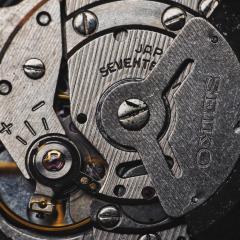-
Similar Content
-
Recently Browsing
- No registered users viewing this page.
-
Topics
-
Posts
-
Do you have the service manual for 3135 as it would explain the procedure then in the absence of that the current procedure for modern mainsprings would be breaking grease on the outer wall as it's an automatic watch. The mainsprings are considered prelubricated no lubrication is required. Then the arbor is lubricated with a suitable lubrication. Typically the only time you see well I haven't ever seen anything quite like that Rolex but Seiko watches often the barrel is filled with some sort of I believe graphite-based lubricant. Or if too much breaking grease was applied in it leaks out but that would be a heck of a lot of breaking grease. I wonder if the black would be molybdenum disulfide? There is a variation of 8200 Quite remember the number were a little bit of molybdenum disulfide Which is a really nice high-pressure powder is mixed in with the eighth 200 and maybe they applied a heaping quantity of that?
-
By steve1811uk · Posted
The watch is from 1990 and was serviced just once around 20 years ago. No idea if the mainspring barrel was ever opened or changed before now. -
Interesting but I think we have a problem here? We probably need to split hairs on a definition problem. For instance take a real Rolex movement put it in a real Rolex case but not the one it came in take a real dial real hands and make up a watch that is 100% real and what exactly is this? If you send your Rolex in for servicing and anything's been changed at all from what it was when it left the factory Rolex will be unhappy and remove all offending components. This does become a problem of people changing things because they think it's their watch and they want to have a different dial Lord diamonds the bezel or whatever words Rolex sees all of this as evil and bad as far as a Intel Rolex only things the watch is legit if everything is exactly what it was when it left the factory and nothing's been changed including the stem everything asked me Rolex original or their very unhappy about its existence. Then you think about a fake watch what is its real purpose? Well its real purpose is to make money for somebody and fool the customer. So all the watch has to do is look pleasant on the outside and inside can be anything. Typically nobody's going to see inside. So typically anything that's not legit counterfeit movement etc. why would someone spend so much time and effort making it look just like a real Rolex when there's no need to? Unless of course you have one or two movements to impress somebody with this is what's inside your watch but even that is problematic Now we don't end up with I've interesting problem that troubles me where I work. The owner will offend a cage your watch by looking at it carefully with a microscope the timing machine etc. and he will point out all the things that he feels are not appropriate correct or whatever for your watch. But in my example above of mixing and matching legitimate Rolex parts he wouldn't necessarily be able to tell. The problem I have with this is it often times things like his claim to telling a counterfeit is look at the second hand the quality of the secondhand is not as nice as a legitimate one. But maybe somebody replaced a second hand on a real Rolex. Or the other day at work I don't know what it was in before but there was a really pretty movement transparent back and they decided it was fake because of? Now I didn't think it was fake I took one look was beautifully manufactured but they had a reason What bothers me with counterfeit Rolex is or anything counterfeit watch related it is reminding me of a witchhunt. The early days of witch hunting how can we tell a which Manon which? That makes me wonder how many super fakes are really fake at all it's basically somebody deciding it's a fake based upon inappropriate assumptions. Like the secondhand is been changed or the watch was worked on the screws are perfect or other things. Other minor problems with super fakes for instance I have a long story the not going to tell the short version is I found the website once where they claim to be counterfeiting Rolex watches. They even had a picture to prove their counterfeit watch the problem with pictures online how do we know it's really a counterfeit watch and not a real Rolex watch that you're telling us is counterfeit. Oh and they had testimonials from all kinds of people who bought their watches and were very happy with the service of course the problem with the watch is you don't know what's inside it unless you take the back off and just because somebody shows a picture online and says this is their super fake maybe it really isn't a super fake they be there just trying to say that. We end up with a interesting problem of manufacturing a watch. Does Rolex actually make every single part found in their watch? Then the year 2004's basically irrelevant. This is because initially Rolex buys stock in the company and they manufacture Rolex watches. I'm assuming over time Rolex will acquire more stock and only in 2004 do they get the whole company. But the company itself hasn't really changed other than the name on the front of the building. The real question is did they really make every single component found in the Rolex watch from the beginning of time until end of the time? A lot of the components found in a watch would be extremely specialized did they make their own jewels or their own mainsprings for instance? But that is looking at the article they employ a heck of a lot of people now I would guess now that Rolex probably does make everything in-house. Especially when they have nifty CNC equipment like for making screws were he could make a huge batch of one type it instantly switch to another type where before he needed specialized machines for one machine for one screw now manufacturing all kinds of stuff in-house becomes very simple. But still is possible that in the early days they might have outsourced something may be perhaps. But conceivably we do have minor changes in thing is due to how things have been made over time which can lead to confusions over whether this is legit or not when it may be as a change of manufacturing methods oh and regarding the screws found in your Rolex watch? In about mid-80s I went to a school reunion in Switzerland. One of things we could do was visit a factory and I picked Rolex because I wanted to see the mass production making of Rolex watches. Which is very disappointed I did not get the sea at all because didn't see them making Rolex watches in their Geneva headquarters even though the building is really fake? So what did we get to see well after sales service because after all were watchmakers we should see that. Did learn something interesting about Rolex screws if your watch was sent to Rolex the screws that come back are not the ones that went there. As they are using powered screwdrivers they don't want to risk breaking heads off and they will replace the screws of every single watch. The other one of interest was suppose there's a scratch and you can see the brass? No problem they have a solution that basically electoral plates without electricity so the scratch goes away. The research Department was quite boring and didn't look like anyone was ever there. Then it was too long ago to remember all the details other than I was disappointed I want to see manufacturing. Yes the joys of artificial intelligence that is more like a trained monkey that's there to please you.
-
By MichaelMVienna · Posted
Hey everybody! I just registered to WRT. I found this forum searching for informations about ELMA watch cleaning machines (will get one ELMA tomorrow ✌️). I'm new in watch repair, collecting watch repair tools to fill up my work space 😎. Greetings from Vienna Michael -
Yeah, I share the experience! 🤣
-





Recommended Posts
Join the conversation
You can post now and register later. If you have an account, sign in now to post with your account.
Note: Your post will require moderator approval before it will be visible.